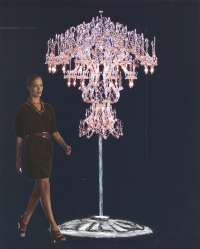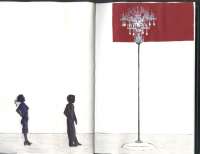Paul Muguet’s Unrealized Project for Year 2011: REVOLUTIONS
Revolutions is about the reversal of popular imagery in times of crisis. The inspiration for this project comes from the European imagery about a country in which everything is reversed: "le pays de Cocagne" is a place that looks like paradise, where nature is generous and men does not need to exploit the land. It is also a place where not only are all values reversed but also its laws of physics. In his book Aspects du Pays de Cocagne. Programme pour une recherche (Edition Vrin, 1979), Frédéric Delpech describes the reasons for this imagery as "a variable image that a specific society needs, particularly in times of deep crisis when such society is incapable of thinking crisis rather than as the urgency of a necessary stage of transformation and a subsequent genesis”.
As such, the project consists in the production of various pieces, of which the first proposal is a series of ceiling lamps turned upside down, that is, instead of hanging from the ceiling, they will erect from the floor. The pieces are French Baroque-style chandeliers made of crystal beads, glass or acrylic. These lamps, which are synonymous and a representative symbol of nobility and aristocracy, will emerge and rise from a classical medallion (usually executed in decorative stucco) arranged on the floor as in a pedestal for a sculpture. The largest chandelier in the series will have a diameter of at least a meter and will be 1,70 m. tall. The chandelier light bulbs will be lit by an electrical installation.
Therefore, the piece will achieve the desired effect, that is to volumetrically replicate the illustrations of the European imagery ranging from the Middle Ages to the sixteenth and eighteenth centuries that describe a world turned upside down, either as a break with the symbolic order of things, or as a violation to the political balance of the world.
Paul Muguet’s Unrealized Project for Year 2011: REVOLUTIONS
Revolutions is about the reversal of popular imagery in times of crisis. The inspiration for this project comes from the European imagery about a country in which everything is reversed: "le pays de Cocagne" is a place that looks like paradise, where nature is generous and men does not need to exploit the land. It is also a place where not only are all values reversed but also its laws of physics. In his book Aspects du Pays de Cocagne. Programme pour une recherche (Edition Vrin, 1979), Frédéric Delpech describes the reasons for this imagery as "a variable image that a specific society needs, particularly in times of deep crisis when such society is incapable of thinking crisis rather than as the urgency of a necessary stage of transformation and a subsequent genesis”.
As such, the project consists in the production of various pieces, of which the first proposal is a series of ceiling lamps turned upside down, that is, instead of hanging from the ceiling, they will erect from the floor. The pieces are French Baroque-style chandeliers made of crystal beads, glass or acrylic. These lamps, which are synonymous and a representative symbol of nobility and aristocracy, will emerge and rise from a classical medallion (usually executed in decorative stucco) arranged on the floor as in a pedestal for a sculpture. The largest chandelier in the series will have a diameter of at least a meter and will be 1,70 m. tall. The chandelier light bulbs will be lit by an electrical installation.
Therefore, the piece will achieve the desired effect, that is to volumetrically replicate the illustrations of the European imagery ranging from the Middle Ages to the sixteenth and eighteenth centuries that describe a world turned upside down, either as a break with the symbolic order of things, or as a violation to the political balance of the world.

